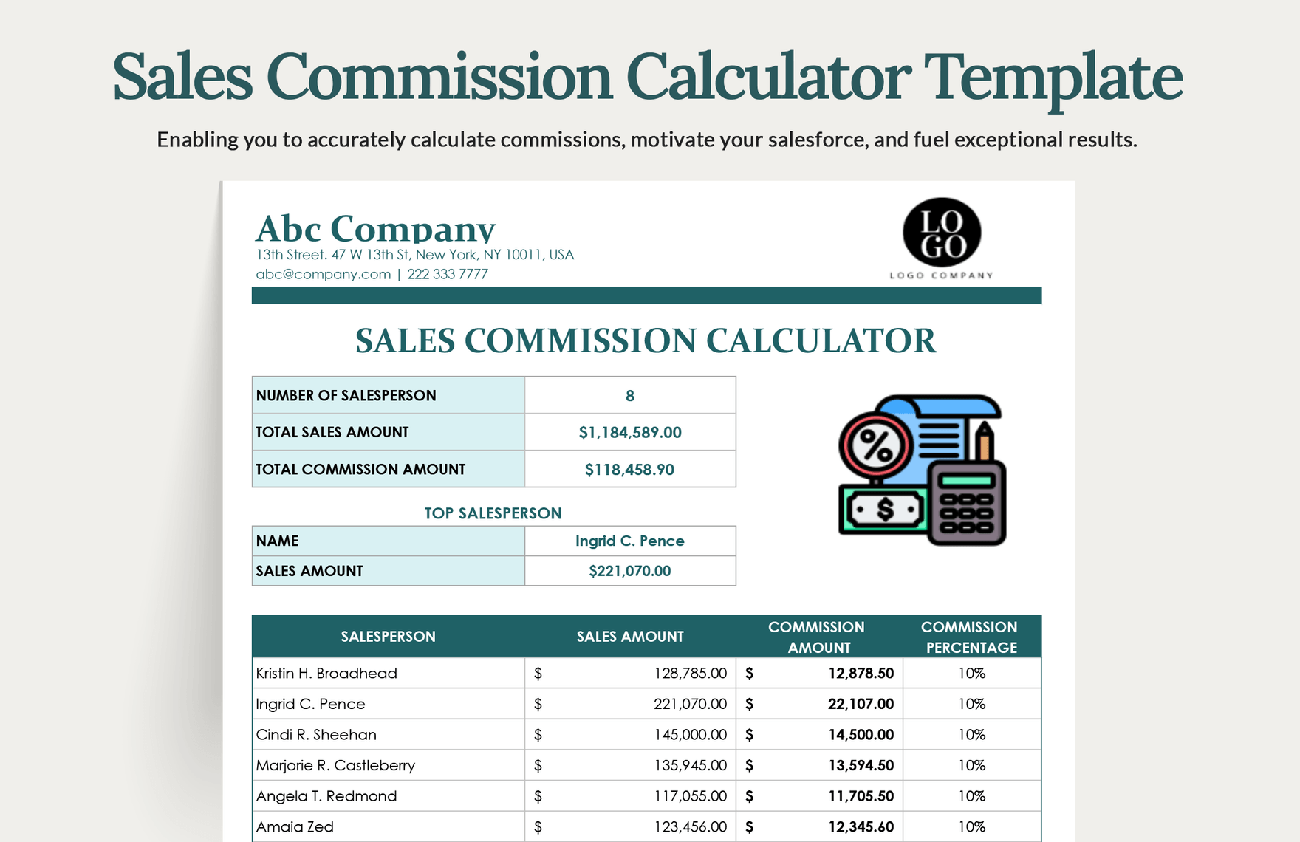How Commission-Based Pay Works: A Simple Guide for New Sales Professionals

Recent data shows that money drives 74% of salespeople in their careers. Commission-based pay remains a significant element of sales jobs. Sales professionals can earn based on their performance through commission pay, which is calculated as a percentage of their sales. To name just one example, a $500 sale with a 10% commission puts $50 in a salesperson’s pocket.
Sales professionals can directly control their earning potential through this payment structure. New sales representatives must understand how commission pay works, whether they choose fixed rates or variable schemes. This piece outlines the fundamentals needed to thrive in commission-based positions.
- Commission pay rewards sales performance, with earnings based on a percentage of sales.
- Common structures include base plus commission, straight commission, and tiered models.
- Industries like real estate, finance, retail, and tech rely heavily on commission-based pay.
- Success requires understanding your commission agreement and managing income variability.
- Top earners target high-commission industries, balance quality vs. quantity, and use smart tools.
- Automated tracking tools reduce errors and boost visibility in commission calculations.
- Negotiating commission terms strategically can increase long-term earning potential.
Understanding the Basics of Commission-Based Pay
Commission based pay works as a financial reward system that lets employees earn money based on their sales performance. The U.S. Department of Labor describes it as “a sum of money paid to an employee upon completion of a task, usually selling a certain amount of goods or services”. Sales professionals might receive this compensation with a base salary or it could be their only source of income.
What is commission pay in simple terms
Sales performance directly determines how much money you make with commission pay. Salespeople get a cut of each sale instead of a fixed paycheck. A salesperson would earn $50 from selling a $500 couch at a 10% commission rate.
Businesses use different commission structures to meet their needs:
- Base salary plus commission: You get guaranteed income plus extra money from sales
- Straight commission: Your entire income comes from what you sell
- Draw against commission: You receive advance payments against future sales
- Tiered commission: Your commission rate goes up as you hit higher sales targets
- Residual commission: You keep earning from repeat customers and subscriptions
Industries where commission pay is common
The United States has over 2.1 million commissioned sales associates. This payment model runs on success in several key industries:
- Real estate: Property sales typically earn agents 2-6%
- Financial services: Advisors start at £30,000 in commissions and can reach £200,000 with experience
- Insurance: New policies and renewals both pay commissions
- Retail: Higher-priced items mean better commissions for sales staff
- Automotive: Each car sold brings commission to the salesperson
- Technology: Software sales teams often get both salary and subscription commissions
The psychology behind commission structures
Commission structures tap into basic human psychology. Herzberg’s two-factor theory shows that money and bonuses are great ways to keep employees satisfied. People also compare their effort and rewards to their coworkers, which aligns with equity theory.
Each commission type affects motivation differently. Tiered systems reward high performers with better rates, which pushes them to achieve more. Adding a base salary to commissions helps people feel secure while staying motivated. This leads to happier employees who take a balanced approach to selling.
A well-designed commission system helps salespeople focus on company goals. Harvard Business School research explains that “compensation systems linked to individual performance outcomes, such as commissions and quota-bonuses, attempt to align the salesperson’s interests with those of the firm”.
How Your Commission Pay Is Calculated

Image Source: Template.net
Sales professionals need to understand how their commission pay works. Your earnings depend on three key elements: formulas, performance tiers, and tracking systems.
Percentage-based commission formulas
The math behind commission calculations is simple: Total Sales ($) × Commission Rate (%) = Total Commission ($). To cite an instance, a $10,000 sale with a 5% commission rate earns you $500 extra.
Commission structures change between industries. Most sales commissions range from 20-30% of gross margins, though rates can vary from 5% to 100% based on specific agreements.
The commission world has many formulas beyond the simple calculation:
- Gross Profit Commission: Commission based on profit margin rather than revenue
- Graduated/Tiered Commission: Rate increases as sales volume increases
- Residual Commission: Ongoing earnings from repeat business
Performance tiers and accelerators
Sales teams use tiered commission structures to set different rates for various performance levels. This system motivates salespeople by rewarding them with higher commission rates as they close more deals.
The step commission plan shows this concept well. It starts with a revenue-based model and has several tiers representing different sales amounts. Salespeople earn higher commission rates as they move up these tiers.
Accelerators boost commission rates after specific milestones, usually after reaching 100% of quota. A salesperson might earn 8% commission until they hit their target, then 12% for 100-150% of target attainment. These accelerators help prevent “sandbagging” – sales reps delaying deal closure after hitting quota to boost next quarter’s numbers.
Commission tracking systems
Sales organizations now prefer automated Incentive Compensation Management (ICM) systems over manual spreadsheets. These platforms pull data from Customer Relationship Management (CRM) systems and calculate commissions with up-to-the-minute data analysis.
Popular commission tracking tools include:
- Spiff: Shows commission data instantly, which builds trust and visibility
- CaptivateIQ: Makes commission calculations 60 times faster
- QuotaPath: Uses AI to build plans and create efficient workflows
These systems cut down calculation errors, save valuable time, and give all stakeholders a clear view of the commission process.
Navigating Your First Commission-Based Role
Starting a commission-based role needs proper preparation and understanding. Sales statistics show 74% of salespeople don’t meet their targets. This makes it vital to be ready before you start.
Reading and understanding your commission agreement
Your payment structure depends on a legally binding commission agreement. The document must spell out:
- When you earn and receive commission
- Your payment timeline (weekly, biweekly, or monthly)
- What happens with refunds or cancelations
- The formula that calculates your earnings
New sales professionals should watch out for “clawback” rules. These rules let companies take back paid commissions if products are returned or services get canceled. Many states now require written commission agreements by law. This makes the document a legal necessity, not just a helpful guide.
Setting realistic income expectations
Make a detailed spreadsheet of your monthly expenses before taking a commission-based job. This shows you the minimum money you need to live.
Look up standard commission rates in your industry next. The typical salary-to-commission ratio stands at 60:40, according to Indeed. Base salary makes up 60% while commission accounts for 40%. Commission-only jobs give you higher percentages of total sales but no guaranteed base pay.
Your first year will see normal income changes. Sales might slow down in December, so plan ahead.
Handling the financial uncertainty
Variable income is your biggest challenge in commission work. Here’s how to handle it:
- Save enough to cover 3-6 months of expenses
- Keep extra money for unexpected costs
- Save more during good months to help during slow periods
Stress management helps a lot. Exercise regularly, meditate, and stay positive to deal with income changes better.
Maximizing Your Earnings in Commission Pay Systems
Success in commission-based pay depends more on smart strategies than just putting in extra hours. Sales professionals who think strategically earn more than their colleagues by prioritizing high-value activities and grasping market dynamics.
Identifying high-commission opportunities
Smart sales professionals target industries and roles that offer the best earning potential. Architecture professionals earn approximately 37% commission per sale, while real estate agents make around 28%. Enterprise sales executives, medical device representatives, and SaaS account executives stand out as top commission earners. Top performers at tech companies like Snowflake, Workday, and Sumo Logic can earn seven-figure incomes.
Balancing quantity vs. quality in sales
The debate between quantity and quality remains crucial for maximizing commission earnings. Research shows that 70% of B2B business owners prefer quality leads over sheer numbers. In spite of that, the best approach often blends both strategies. Quality-focused selling boosts conversion rates and builds brand authority, while broader outreach helps discover unexpected opportunities. A sales director’s advice rings true: “disqualify fast” to focus on promising prospects efficiently.
Learning from top commission earners
High performers share several habits that drive their success. They vary their sales portfolio between short-term, mid-term, and long-term sales cycles to keep income steady. They employ sales performance management (SPM) software to analyze customer data and spot the best opportunities. These professionals also put money into ongoing training to boost their sales skills.
When to negotiate your commission structure
Smart timing of commission structure talks yields better results. Research industry standards and gather your performance data before starting negotiations. Show how your work affects the company’s bottom line. Think about suggesting tiered commission structures that reward you more as you exceed sales targets. Most importantly, assess whether your commission structure matches your career goals.
Conclusion
Sales professionals who know how to work the commission system can earn substantial income. This piece shows everything in commission structures – from simple percentage calculations to advanced tiered systems.
Your success in commission roles depends on three vital factors. A full picture of payment structures helps sales professionals create realistic expectations. Good financial planning tackles income variability challenges. The right approach to finding and pursuing high-value opportunities helps realize the full potential of your earnings.
Note that commission work rewards both hard work and smart strategy for new sales professionals. The learning curve might seem tough at first. Yet becoming skilled at these fundamentals builds a strong foundation for a rewarding sales career. Knowledge about commission calculations, agreement terms, and proven success strategies empowers sales professionals to chase their income goals with confidence.
The most important thing is to keep learning and adapting to achieve lasting success in commission-based roles. Markets keep changing and new opportunities pop up. Successful sales professionals track industry trends and fine-tune their approaches regularly.
